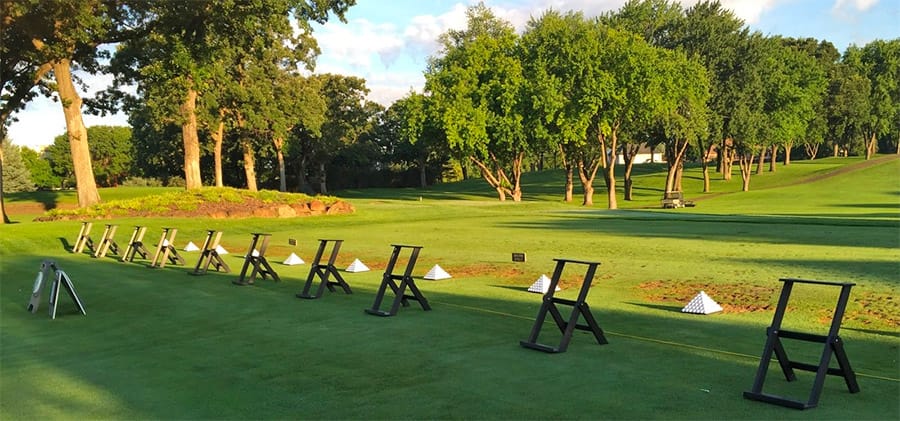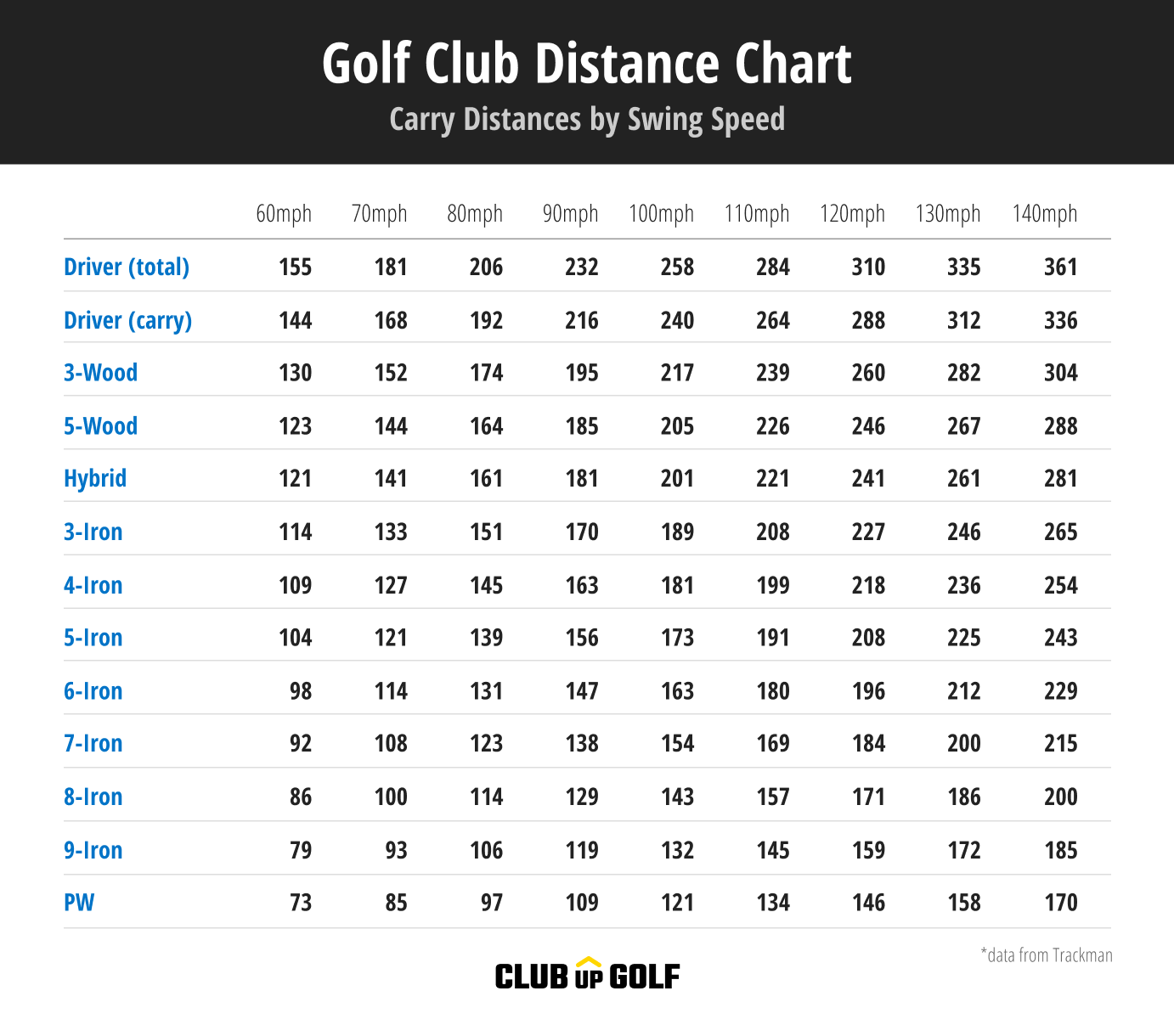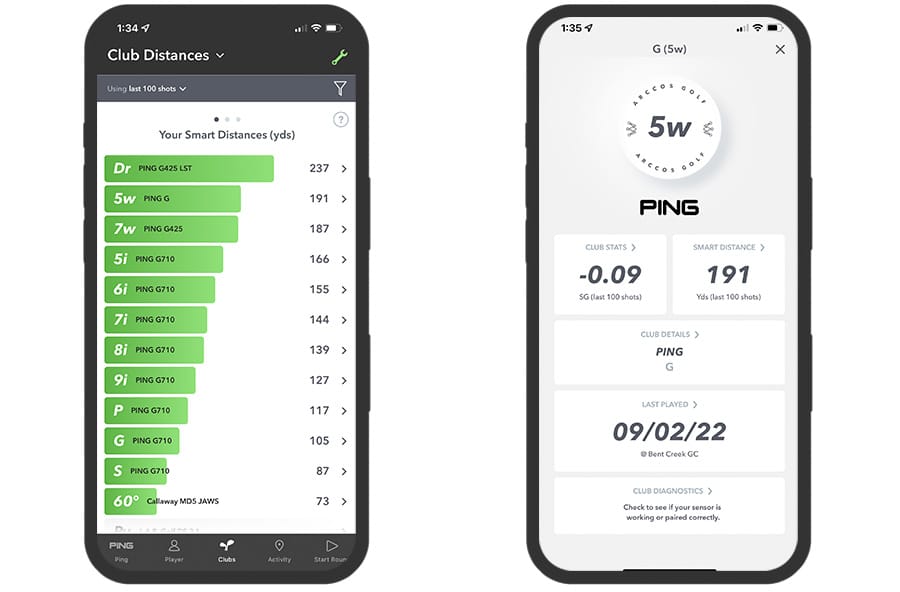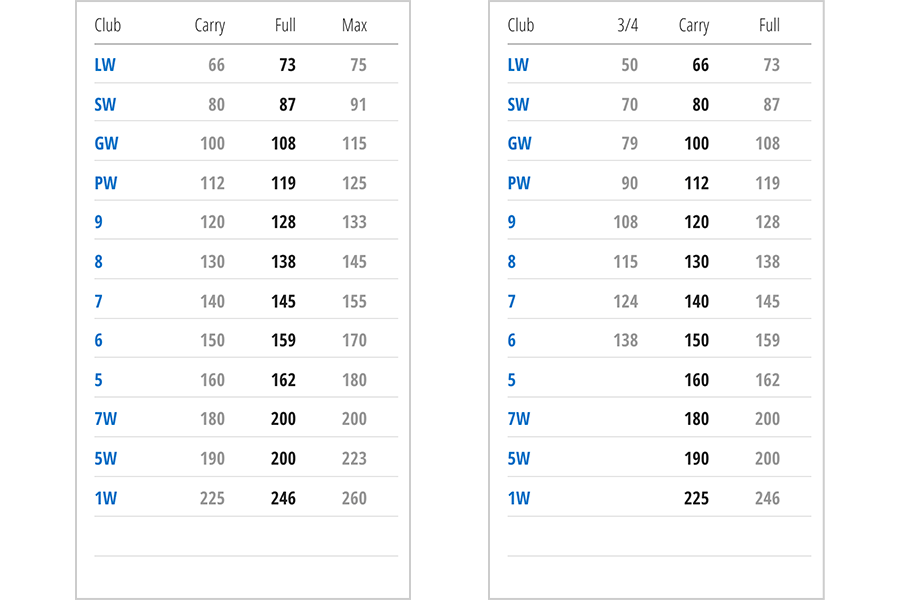Golf Club Distance Chart
This post may contain affiliate links. As an Amazon Associate I earn from qualifying purchases.
This golf club distance chart will help provide you with a guide to how far you should hit your golf clubs. You’ll also be able to tell what level you’re at compared to the pros and how increasing your swing speed will impact your yardage.

Table of Contents
Golf Club Distance Chart by Swing Speed
This table from Trackman shows the average distance for golf clubs based on the swing speed of a driver. Of course, your distances will vary based on how well you’re striking the ball, but this cheat sheet should give you a good idea of how far you can expect your clubs to go when hit well.
Note that these are carry numbers. So you might expect from 0-10 yards of extra distance depending on the club, how it’s struck, and where it lands.
| 60 | 70 | 80 | 90 LPGA | 100 | 110 PGA | 120 | 130 | 140 | |
|---|---|---|---|---|---|---|---|---|---|
| Driver (total) | 155 | 181 | 206 | 232 | 258 | 284 | 310 | 335 | 361 |
| Driver (carry) | 144 | 168 | 192 | 216 | 240 | 264 | 288 | 312 | 336 |
| 3-Wood | 130 | 152 | 174 | 195 | 217 | 239 | 260 | 282 | 304 |
| 5-Wood | 123 | 144 | 164 | 185 | 205 | 226 | 246 | 267 | 288 |
| Hybrid | 121 | 141 | 161 | 181 | 201 | 221 | 241 | 261 | 281 |
| 3-Iron | 114 | 133 | 151 | 170 | 189 | 208 | 227 | 246 | 265 |
| 4-Iron | 109 | 127 | 145 | 163 | 181 | 199 | 218 | 236 | 254 |
| 5-Iron | 104 | 121 | 139 | 156 | 173 | 191 | 208 | 225 | 243 |
| 6-Iron | 98 | 114 | 131 | 147 | 163 | 180 | 196 | 212 | 229 |
| 7-Iron | 92 | 108 | 123 | 138 | 154 | 169 | 184 | 200 | 215 |
| 8-Iron | 86 | 100 | 114 | 129 | 143 | 157 | 171 | 186 | 200 |
| 9-Iron | 79 | 93 | 106 | 119 | 132 | 145 | 159 | 172 | 185 |
| PW | 73 | 85 | 97 | 109 | 121 | 134 | 146 | 158 | 170 |
Printable Golf Club Distance Chart
If you’d like to print this chart out, click on the image below or download this golf club distance chart pdf.

Average Swing Speed by Player Type
Here are the average swing speeds by type of player. These numbers vary widely, especially among amateurs, but they can give you an idea of where you stand among your peers.
| Player Type | Average Driver Swing Speed |
|---|---|
| Average Female | 80 mph (79-87) |
| Average Male | 94 mph (80-100) |
| LPGA | 94 mph (90-100) |
| PGA Tour | 113 mph (110-120) |
| Long Drive Competitor | 135 mph (130-157) |
Average Swing Speed by Handicap
The distance you can hit your clubs directly correlates with your potential handicap. Of course, your actual handicap number will vary based on all the factors of your game, but these are the expected averages for males and females.
| Male Handicap | Average Driver Swing Speed |
|---|---|
| Scratch or better | 110 mph |
| 5 hcp | 101 mph |
| 10 hcp | 95 mph |
| 14.5 hcp (average golfer) | 94 mph |
| 17.5-22.4 hcp (bogey golfer) | 92 mph |
| Female Handicap | Average Driver Swing Speed |
|---|---|
| Scratch or better | 90 mph |
| 5 hcp | 87 mph |
| 10 hcp | 83 mph |
| 15 hcp | 79 mph |
Average Driver Distance by Age
The table below shows the average driving distance by age. Your actual numbers will vary based on your fitness and skill. As people age, they tend to lose fast twitch muscle fiber and flexibility unless they’re actively working to maintain them.
| Age | Driver Distance |
|---|---|
| 20-29 | 239.7 – 243 |
| 30-39 | 233.7 – 241 |
| 40-49 | 225.9 – 232 |
| 50-59 | 215.4 – 224 |
| 60-69 | 204.5 – 212 |
| 70+ | 190.4 – 196 |
How to Find Your Driver Swing Speed
There are several ways to find your swing speed to place yourself on this chart.
The simplest way is to get the yardage for one of your clubs, such as the driver, and match that yardage to the chart. You should find one of the columns closely matches your yardages. Ensure you’re tracking average yardage and not your best drive to get accurate numbers.
Here are several other ways:
- Use a golf simulator to get an accurate swing speed number. A device like a Trackman or a Skytrak should be able to provide you with this data. If you don’t have a simulator, you may be able to find somewhere nearby where you can rent time in a simulator bay.
- Use a launch monitor like the PRGR (around $200), which accurately measures speed.
How to Make Your Own Club Distance Card

To make your own club distance card, you’ll need to start by measuring each club’s carry and/or total distance. There are several ways to get this data:
- A golf simulator (you can rent simulator time if you don’t have access)
- A launch monitor (such as the PRGR mentioned above)
- A golf tracker (such as the Arccos Caddie)
- A range finder and some time at the driving range (this approach is less precise and takes extra effort)

Choose which data is most helpful. For example, carry distances are useful for hitting a green or ensuring you can get over trouble, and the total distance helps you know your range. You can also track distances for partial swings (like a 1/4, 1/2, or 3/4 wedge).
After you’ve gathered all the numbers, there are several ways you can use them to make your club choices easier on the course:
- Paper – the most basic way is to write them down on some note paper; you can use the templates below for an idea of what to write down.
- Phone – you can save these numbers as a note or document for reference if your phone is easily accessible during your golf round. Apps like the Arccos Caddie (mentioned above) will also track this for you.
- Print Out – we’ve included some sample templates below to give you ideas on how to design a card.


Once you have your distance card, you can laminate and carry it, put it in a scorecard holder, attach it to your bag with a bag tag holder, or tape it to your push cart.
FAQs
You should expect to hit a 7-iron between 130 and 160 yards. Each iron should vary by about 8 to 10 yards (e.g., if your 7 goes 150, your 8 should go around 140). This will change depending on your swing speed, which is related to your technique, flexibility, fitness, and height.
An average male swings the driver at 94 mph, traveling around 240 yards. However, most amateurs don’t hit the ball perfectly, so this will often fall short of this potential yardage when mishit.
A PGA Tour player hits the driver an average of 295 yards (some are much longer, like DeChambeau at 320 yds). An LPGA player drives the ball around 240 yards in total.
In 2021 Kyle Berkshire hit a ball speed of 233.4 mph with a swing speed of 153.3 mph. His swing speeds have been slightly higher, but ball speed ultimately factors most into the distance.
Sources:
4 Comments
-

-

-

-

Add a CommentJOHN T. HARTMANN
Last check, my golf swing speed has been around 98 to 100mph. So as a reference I hit my 7-Iron about 165yds on average, pitching wedge would be 130 to 140yds and driver 230 to 260yds depending upon contact and degree of flight.
I can handle tee spots up to 6700 to 6800yds. However, my wife thinks I should “play-up” because my scores are “mid 90’s on challenging course, but my issues have always been the short game, not distance. What do you suggest?
SS
Regarding John Hartmann’s comment….play the tees where you have the most fun. If all your buddies are playing from the same tees as you maybe you want to just keep playing those same tees with your friends. Most of us are just playing for fun. Play where you have the most fun but if I were you I’d at least give it a try moving up. 6800 yards is a lot of golf course for weekend golfers. Who knows, you might have more fun making lower scores from closer tees.
Kyle J. Larson
Yeah, play whichever tees you like, but like SS said 6800 is probably a lot if you’re not hitting a driver at least 260+… if you take a look at the par 3 distances, and shots you may have to hit into greens on a 2nd or third shot (after subtracting your avg driver distance) it’ll help you figure out what to play. I’m going to have a lot more fun hitting irons into a green and having some birdie chances then if I’m always trying to crank a fairway wood in and missing or having long putts.
Paul W
I’m 80 years old and hit my driver pretty consistently 200-210. Since moving to the up tees I have had so much more fun. Now it’s driver and a medium iron rather than driver, fairway wood, pitching wedge. Having a chance to make some birdies makes all the difference in enjoyment for me.